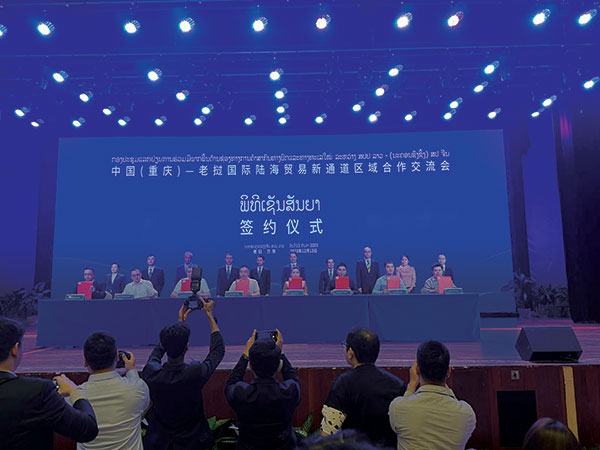Laos, China’s dry ports form partnership for efficient rail transport
The operator of the Thanaleng Dry Port, Laos’ integrated logistics centre, and the operator of China’s Chongqing Dry Port recently signed a cooperation deal to bolster transport and logistics capacity and efficiency and drive trade and investment in the region.
The enhanced partnership aims to improve transport between the two dry ports using the Laos-China railway, an important trade gateway between China and Southeast Asian countries.
The agreement was signed on the sidelines of the China (Chongqing)-Laos New International Land-Sea Trade Corridor Regional Cooperation and Exchange Conference held recently in Vientiane.
Following the signing, railways are set to directly shift 32 cargo containers from Chongqing Dry Port, an important logistics centre in southern China, to the Thanaleng Dry Port in the Lao capital Vientiane where the Laos-China and Laos-Thailand railways converge.
Since the Laos-China railway and the Thanaleng Dry Port became operational in December 2021, the trade route has transformed land-locked Laos into a land-linked hub in the Indo-China Peninsula, helping Laos effectively overcome its development barriers.
It has also bolstered cost-effective logistics in the sub-Mekong region. Exporters say transport costs between Thailand and China using the railway have been cut by about 30 percent compared to road transport, thus enhancing business competitiveness.
The China-Laos railway carried over 3 million tonnes of goods in the first eight months of 2023, an increase of 138 percent year-on-year. The volume of goods imported by Laos from China reached 344,700 tonnes, while goods exported from Laos to China reached 2,752,200 tonnes.
The Thanaleng Dry Port last year handled more than 50,000 containers, averaging more than 4,000 containers a month. The number significantly rose to more than 7,000 containers a month over the first six months of 2023. The containers were destined for countries such as Thailand, Vietnam, Cambodia, Myanmar, Malaysia, Singapore, China and Russia.
The trade route also links Southeast Asia to Europe. From the multimodal Thanaleng Dry Port, the route links to Thailand, Malaysia and Singapore.
Through the rail network, which forms a crucial part of the global infrastructure network known as the Belt and Road Initiative (BRI), trains from Laos pass through China, Kazakhstan, Russia, Belarus and Poland and terminate at Duisburg in Germany.
Given the significant role the trade route plays, senior officials from Laos and China attending the China (Chongqing)-Laos New International Land-Sea Trade Corridor Regional Cooperation and Exchange Conference pledged to forge increased interconnectivity in the spirit of the BRI to boost trade and investment in the region and beyond.
In his speech, the Deputy Mayor of the Chongqing Municipal People's Government, Zheng Xiangdong, said Chongqing will build China-Laos high-quality BRI, while strengthening the interconnection of infrastructure along the China-Laos railway, and improve multimodal transport and the quality of logistics services.
For his part, Lao Deputy Minister of Industry and Commerce Manothong Vongsay said “Laos is willing to carry out pragmatic cooperation with Chongqing in various forms and fields.”
He added that the Laos-China railway under the BRI has enabled China and Laos to achieve interconnection and facilitate trade and investment between Laos and China and countries in the Mekong subregion.
During his trip to Laos, Mr Zheng Xiangdong and executives from the Chongqing Dry Port also visited the Thanaleng Dry Port International Border Checkpoint (Cargo Terminal) where they were briefed about the dry port and its associated Vientiane Logistics Park.
The dry port and logistics park are part of the Lao Logistics Link project, being developed by PTL Holding Company Limited. This strategically important project also includes the Vung Ang seaport in Vietnam’s central Ha Tinh province, a planned railway linking the seaport to the dry port in Vientiane, and a dry port in central Khammuan province through which the railway will pass. Through Vung Ang, freight can reach markets in the Pacific region, thus providing another trade opportunity.
The Vientiane Logistics Park is being built to encourage more foreign investment and business in the export processing zone, logistics park, free trade zone, technology and halal hub and more, to add value to the growing transport connectivity.
By Advertorial Desk
(Latest Update December 29, 2023)
|


